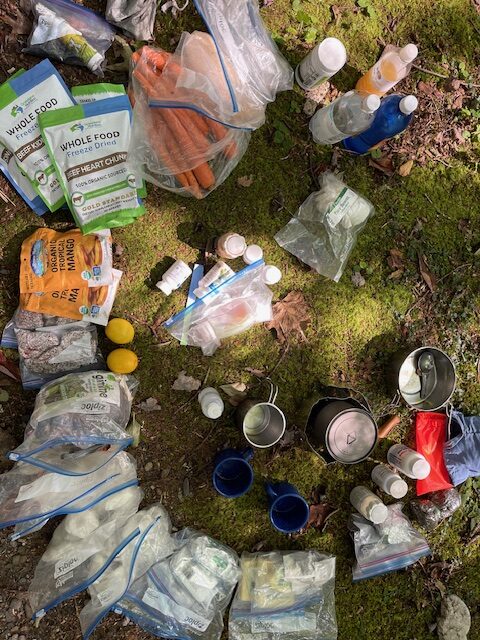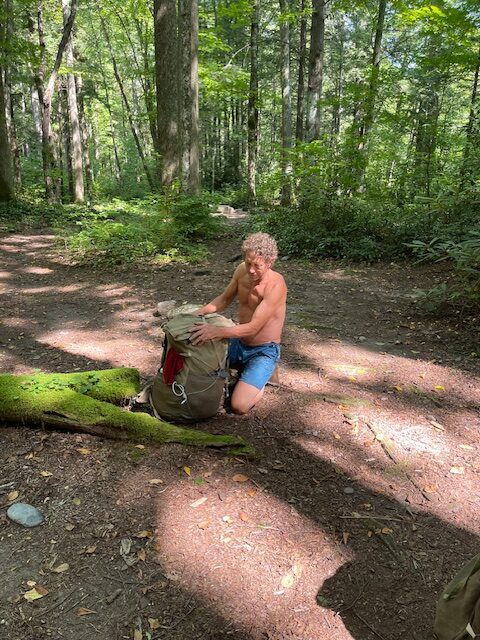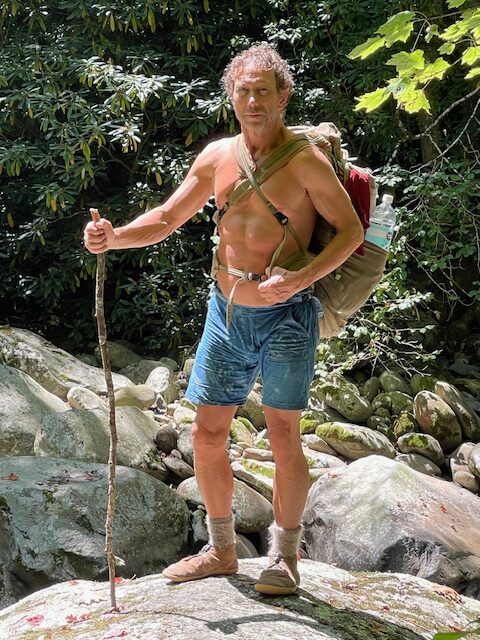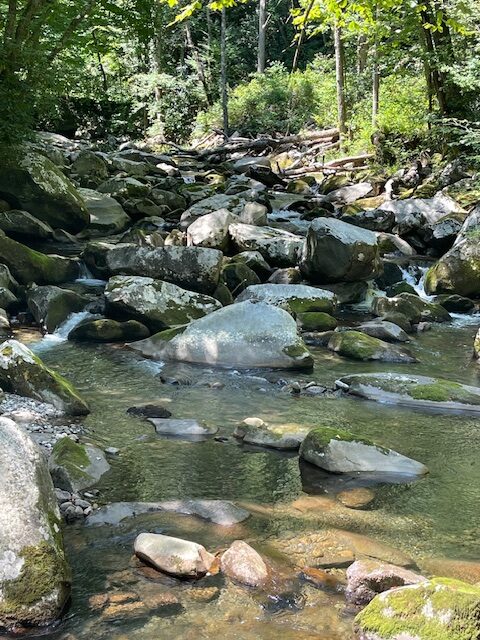The trail was wide and relatively flat, with a gentle uphill incline. We felt up for the challenge. As the water crashed against the boulders, we breathed in the refreshing negative ions, savoring the sights and sounds of the deep forest. Majestic views greeted us as the trail led us along sheer cliffs, with massive fallen trees lying silently against the rugged terrain like sleeping giants.
A Personal Pilgrimage
I make an annual pilgrimage to my favorite water place in the Great Smoky Mountains National Park. This has been my place of healing and refuge for many years, and it’s close to the town where I grew up. Most of the time, I’ve gone alone, always testing my gear and new food ideas that I hadn’t fully developed. But this year, I invited some friends to join me. They had never been backpacking before and were interested in trying out the Lucky Sheep gear I would provide. They were also curious about experiencing a mostly carnivore or Paleo diet.
Preparing for the Adventure
In the two weeks leading up to the trip, I prepared by making pemmican and getting all the gear ready. Jeff and Lyra, my friends, were unaware of the typical backpacking diet, which often consists of carb-based foods lacking in reasonable nutrition and filled with plant toxins. For instance, a common backpacking menu includes oatmeal for breakfast, peanut butter sandwiches for lunch, dried nuts and M&M’s for snacks, and mac n’ cheese for supper. There’s hardly any healthy animal-based protein or fats in this type of menu. This is why I’ve spent so much time experimenting, researching, and developing a new approach that emphasizes optimal nutrition to meet the physical demands of backpacking.
On the Trail: Food and Gear
We hiked until a little before dark, stopping briefly for supper to fuel the miles ahead. As darkness slowly enveloped the forest, the trail offered no relief. Rocks threatened to trip and twist ankles as we grew weary. Finally, we arrived at our campsite, greeted by an empty site in the wild night.
After dropping our packs, we tried the pemmican I had made—a welcome relief after pushing ourselves beyond our comfort zones. Pemmican is a traditional Native American food, ideal for modern backpacking just as it was for the French traders and Native Americans who preserved food during buffalo hunts.
The pemmican consisted of four pounds of fresh grass-fed steak, cut into strips and dried in a food dryer. After grinding it in a blender, I mixed it with 48 ounces of grass-fed beef tallow, yielding 54 ounces of pemmican. I also brought along eight ounces of an older batch with dried blueberries. This, combined with butter, dried fruit, and a bit of rice for two suppers, turned out to be the perfect amount of food.
Settling In for the Night
I gave my friends a quick lesson in pitching the tarps and using their Lucky Sheep Rewilder sleeping bags. We hung the food on hooks hoisted up on cables to keep it out of reach of bears. The campsite had been closed for weeks and only reopened the day before our trip, so we had it entirely to ourselves. Despite some apprehension about bear safety, we quickly fell asleep to the serenade of the creek and locusts filling the night air.
The Next Morning: Sorting and Snacking
The next morning, I dumped all the unorganized gear onto the ground to sort it out. Each of us carried a stuff sack full of about eight pounds of food—just about right according to the general rule of thumb of two pounds per person per day. Much of this food was experimental. We didn’t know if it would be enough or if we’d like the menu, but we were about to find out.
We started with coffee and somewhat bland pemmican. One handful, or about four ounces, sufficed for a meal, with three meals and a snack each day. We complemented this with dried fruit, heart or kidney chunks, a few slices of raw cheese, and some butter. Instead of dividing it up equally, we agreed to eat from the same food bag as we went. The next trip will include more planning about how the food is organized and distributed.









The Joy of Mild Weather
This trip turned out to be as easy as a camping trip can get—there wasn’t a drop of rain in the forecast. We were prepared for rain, as a backpacker always needs to be, but we didn’t even need our tents or beeswaxed canvas rain jackets. In fact, we could have gotten by without sleeping bags. But the whole idea is to use each trip as a training ground for exploring the art of outdoor adventure. Since this was Jeff and Lyra’s first backpacking trip, the mild weather was very welcome.
The Lucky Sheep Gear Experience
We each had the latest Lucky Sheep products: a wool sleeping bag (the “Rewilder,” rated at 20 degrees), a beeswaxed canvas rain shell, and an 80L beeswaxed backpack. Our clothing included merino wool lightweight base layers, cotton shorts or pants, a light sweater, and the rain shell. With our lightweight silnylon tarps, a six-ounce alcohol-burning stove with fuel, first aid kits, and a few other items, our packs weighed about 14 pounds before adding food and water. Adding 10 pounds of food and water, we each carried about 25 pounds.
Since I started designing gear at Lucky Sheep eight years ago, the goal has been to create backpacking gear with natural fibers comparable to modern synthetic counterparts. Here’s the breakdown of gear for this trip:
- Backpack: 2 pounds
- Sleeping bag: 4 pounds
- Clothes: 3 pounds
- Rain Shell: 2 pounds
- Shelter: 2 pounds
- Stove and cooking utensils: 8 ounces
- First aid: 8 ounces
- Toiletries: 8 ounces
- Electronics: 12 ounces
- Maps: 4 ounces
- Food: 8 pounds
- Water: 4 pounds
- Reading/writing material 8 ounces
This totals about 15-16 pounds base weight (before food and water), which isn’t significantly different from modern backpacking gear. And considering the advantages of going all-natural, I think this system rocks. It’s comfortable and breathable in warm weather, and when extreme moisture and cold hit, it will perform even better. It was nice to be in breathable, moisture wicking wool clothing and bedding while camping with the mist of the creek.
The Simplicity of Camp Cooking
We didn’t really need to cook at all, but it was nice to have some rice stir-fried with garlic and wild mushrooms with our pemmican in the evenings, along with hot coffee for breakfast.
Exploring and Unanticipated Adventures
This trip was about rest and relaxation, as well as teaching and learning basic backpacking skills. We didn’t push for miles, instead opting to keep one base camp and do day hikes from there. We explored the nearby creeks and trails, soaked in ice-cold waters, and basked on sun-soaked rocks. Perhaps the most exciting part of the trip was when we stumbled upon what we thought was a snake, but turned out to be a giant pile of animal poop—still unidentifiable, but definitely not from a bear.
Later, we discussed what would happen if a bear attacked. We didn’t have bear spray, so we agreed we’d defend each other if necessary. Right after that, we walked over a bees’ nest, and Lyra got stung multiple times as Jeff and I swatted the bees away and told her to run. Eventually, we found a way to reach the creek, where Lyra could soak her stings. We had left our pack with the first aid kit and camera further back, which was our one mistake. But we made it back to camp safely, ready to reflect on the adventure.

